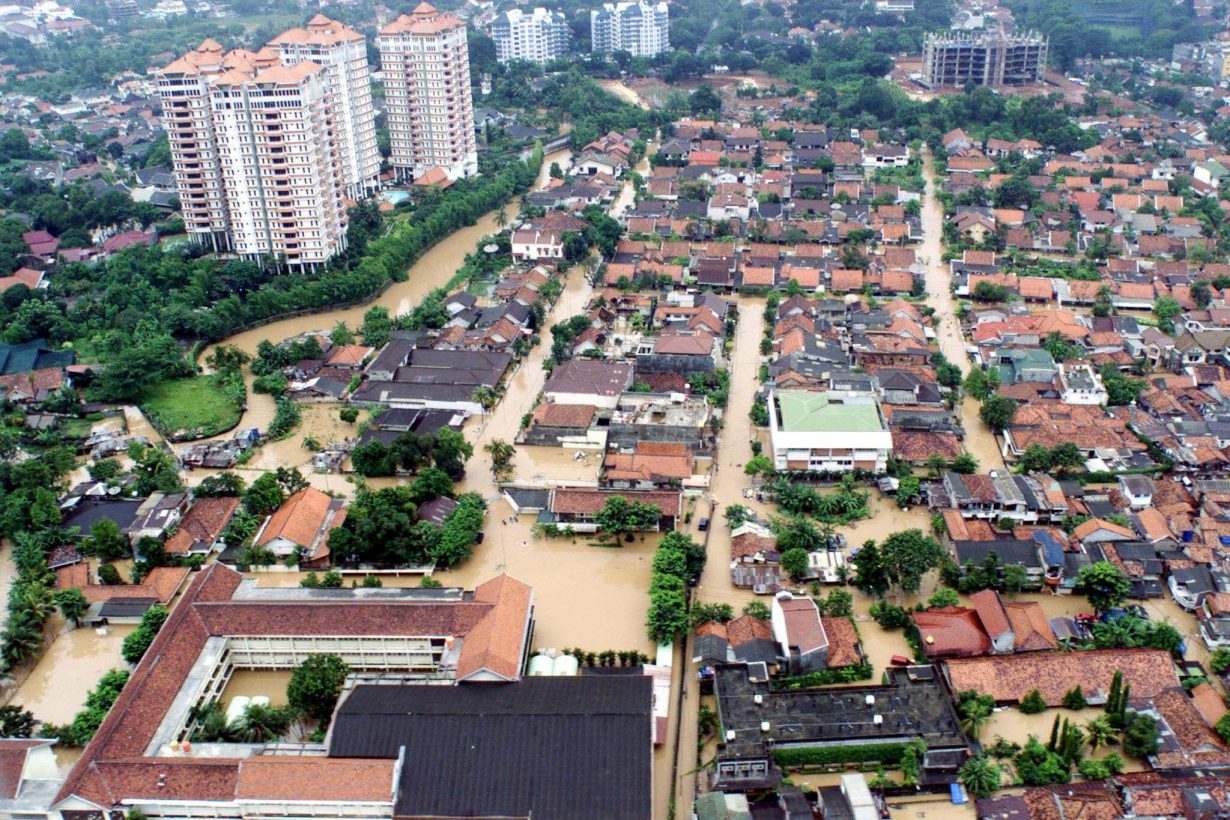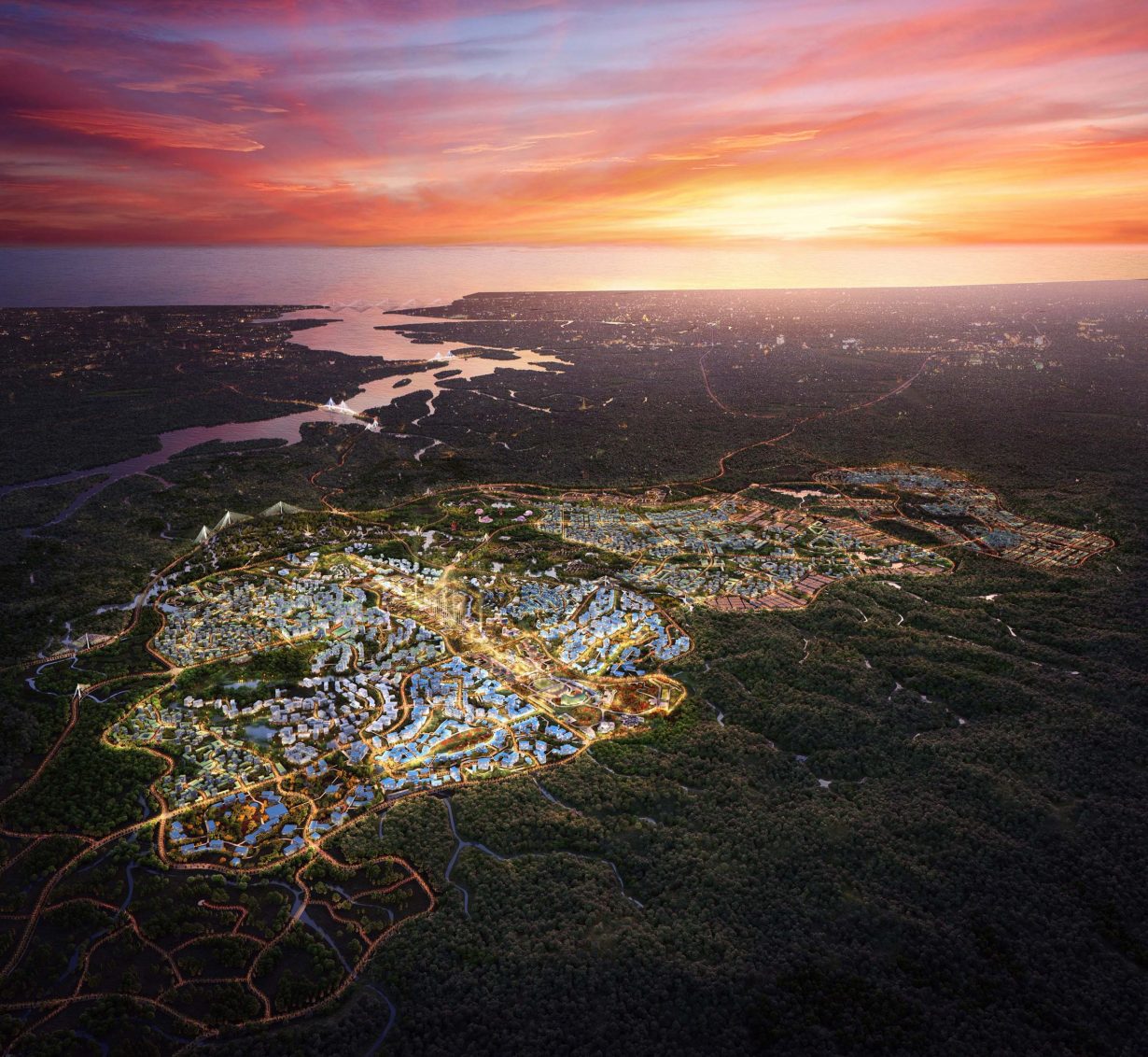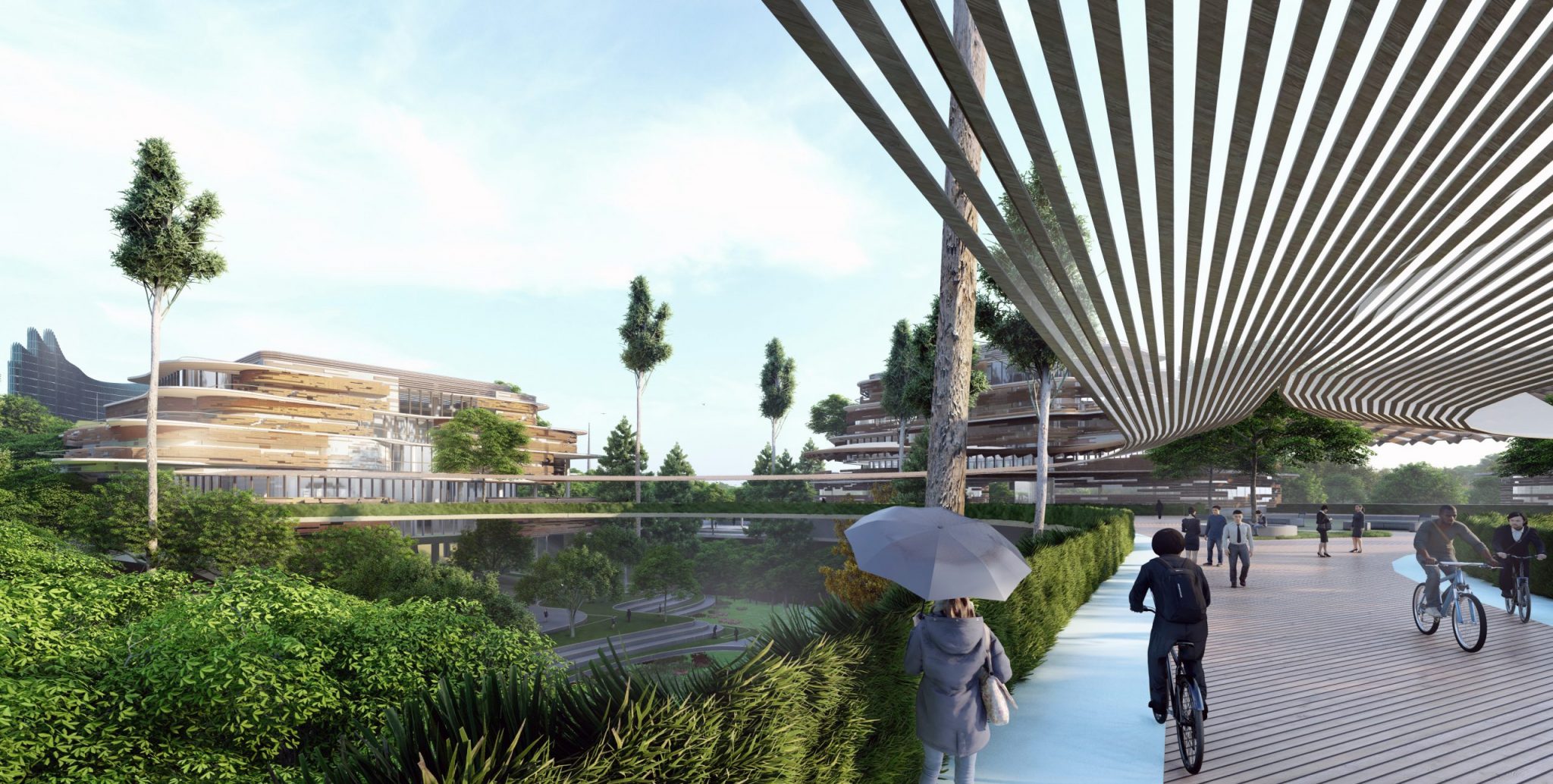Jakarta is sinking. As Indonesia begins a process of relocating its capital city to East Borneo, and to a newer, greener architecture – albeit accompanied by the forced displacement of thousands of indigenous peoples – can this really represent a fresh start for the nation?
The camera soars above a city filled with forests, skywalks, biodomes and waterways. A city of the future. People are gathering within handsome, tree-lined plazas and cycling along sun-dappled bike lanes. On the roads are self-driving electric cars; in the sky, birds and helicopters labelled ‘Drone Taxi’. High up on a hill, fluttering against the blue sky, is the red-and-white flag of Indonesia. Welcome to Nusantara, the nation’s new capital.
It is situated in the rainforests of East Kalimantan in Borneo – or at least it will be according to the slick, computer-generated visualisation of it that is available on YouTube. The video was produced by Urban+, an Indonesian architecture and design firm that won a government competition, organised in 2019, to masterplan the new city.
Videos aside, there is something a little ironic about ‘Nusantara’, an old Javanese word (meaning ‘archipelago’ but associated with the territory conquered by a fourteenth-century Javanese military general), being deployed to sell the dream of a new Indonesia. With its abundant nature, net-zero emissions target and green space less than ten minutes away from everyone in the city, it is the antithesis of the city it is designed to replace: the congested, polluted and – most importantly of all – sinking city of Jakarta, which has been the nation’s capital since independence in 1945. The relocation is to be completed in five phases, finishing by 2045; with phase one – a 6,000ha zone known as the Government Central Area (comprising government offices, schools and hospitals) – scheduled to be completed by February 2024. The plan, according to President Joko ‘Jokowi’ Widodo, is that the official celebration of Indonesia’s Independence Day, on 17 August, will be held at his new palace.

Projected to cost US$34 billion and with its ambitious construction schedule, the scale of this historic undertaking is staggering. Nusantara will cover a total area of 2,560 km² (about three-and-half times the size of Singapore), for which gargantuan plots of land need to be cleared and an estimated 20,000 indigenous people moved out. In the first phase of development, from 2024 to 2029, it is estimated that 100,000 state employees will relocate to East Kalimantan; the target population for 2045 is 1.7 to 1.9 million residents. To accommodate them, basic infrastructure (housing and roads) needs to be built at breakneck speed. But the question of who, precisely, is footing the bill for all this remains a concern.
A little under one-fifth of initial outlay will be provided by the Indonesian state; the rest needs to come from state-owned businesses and both local and international investors – which in itself will not be easy given that this is a high-risk project that might not necessarily be continued by the next administration, given that Jokowi’s term ends in 2024 (and that a survey of Jakarta residents taken at the time of the architectural competition suggested that 95.7 percent of the population were against the move).

Nevertheless, the current government is pushing towards its stated deadlines. Perhaps because practical concerns have been eclipsed by the symbolic significance of the Nusantara project. In his state-of-the-nation address in 2019, Jokowi said, ‘The [new] capital is not only a symbol of our nation’s identity, but also represents our nation’s development’. Indeed, Nusantara communicates Jokowi’s new narrative of economic progress, which is moving away from a Jakarta- and Java-centric model of development to what he calls an Indonesia-centric one, with more equitable distribution of power and resources across the archipelago.
Java-centrism is a problem for Southeast Asia’s most populous nation, which comprises more than 17,000 islands and over 1,300 officially recognised ethnic groups. Java, which is the island on which Jakarta lies, occupies only seven percent of the republic’s land area but is home to approximately half of Indonesia’s population (making Java the most populated island in the world) and contributes up to 60 percent of GDP. In comparison: Kalimantan contributes less than ten percent of the nation’s GDP and is home to less than seven percent of the population.
In the Geopolitics of Spectacle (2018), urban geographer Natalie Koch argues that spectacular developments in capital cities rely on ‘the metaphor of synecdoche’, a figurative device in which the part stands in for the whole. They are, she states, a kind of ‘political technology’. Koch was focusing the discussion on the city of Astana, which was designated as Kazakhstan’s capital during the late 1990s after the country broke off from the Soviet Union and President Nursultan Nazarbayev claimed in 2010 that ‘the modern Astana is Kazakhstan in miniature’, a post-Soviet capitalist wonder with a futuristic skyline. It’s easy to see how her argument can be extended to Nusantara. Except in this case, Nusantara does not express the flourishing capitalism that was demanded under Nazarbayev’s regime; rather it offers a ‘respectable’ eco-modernisation through which neoliberal agendas can be legitimised or greenwashed.

Nusantara is designed to be a show city and flagbearer for Indonesia’s political aspirations. By its 100th year of independence, 2045, the republic aspires to reach the status of a ‘developed country’ and the fifth largest economy in the world with a GDP of US$7.3 trillion and per capita income reaching US$25,000. As the only Southeast Asian country in the G20, a bloc composed of the world’s largest economies, Indonesia announced it is targeting to reach net-zero emissions by 2060. Smart, sustainable, with clean air and open roads, Nusantara performs the republic’s legitimacy – even leadership – in a developed, high-income and climate-conscious international community.
How Nusantara does it is partly by rafting an image that intertwines national identity with the environment. Sibarani Sofian, director of Urban+ and Nusantara’s urban planner, came up with the tagline nagara rimba nusa – Bahasa Indonesian for ‘city forest islands’ – a spatial conception that expands from small to big, proceeding from the administrative capital (nagara) to the Borneo jungle (rimba) and finally to the archipelago identity of the entire republic (nusa), to fuse the ideas of nature and culture.
Meanwhile, Nusantara’s blueprint also projects a geopolitical imaginary that marries ‘indigeneity’ with the international standards of a modern city. Sofian tells ArtReview Asia that the city plan follows the typical right-angled axes of major Western cities, like the Voie Triomphale in Paris, which runs through the Tuileries Garden and Champs-Elysées, and Washington, dc’s arrangement with the Washington Monument at the intersection. However, Nusantara’s axis is informed by a pre-Islamic Javanese cosmology. The city’s vertical axis faces higher ground, as a mountain represents Heaven and ancestors. Then the city’s horizontal axis flows down towards Balikpapan Bay, with the sea representing the rest of the world.

Despite its utopian aspirations, critics question whether Nusantara truly embodies a real structural rehaul of national identity, as well as true economic transformation towards a more equitable society. First, the name Nusantara is itself problematically Java-centric. A name drawn from other Indonesian cultures, say, ones indigenous to Kalimantan, would have made a stronger statement about celebrating diversity.
Second, one can argue that the move to Nusantara might be driven less by public interest than by an old-school elitist confluence of money and political influence. Civil society organisations have pointed out various oligarchic financial interests involved in the choice of Nusantara’s location. Several national and local politicians and their families own concessions for forestry, mining and oil palm plantations in the area and potentially stand to benefit from state compensation.
Finally, despite their idealistic projections, without radical reforms across the board, existing political-economic structures will continue to infiltrate these new urban experiments and undermine their ambitions. It is too early to say if Nusantara will succeed or fail, but tellingly, the Indonesian government has repeatedly cited Brasilia as its model. In 1960 Brazil moved its capital from crowded, coastal Rio de Janeiro to a scratch-built centre in the country’s hinterlands. The new city parallels Nusantara in that it was meant to relieve a clogged capital and boost the economy in the countryside. Brasilia also represented the programme of aggressive self-modernisation under President Juscelino Kubitschek de Oliveira, who famously campaigned under the slogan ‘Fifty Years in Five’ back in 1955, promising 50 years of growth in a tenth of that time.
Yet Brasilia presents a cautionary tale about cities purpose-built to showcase an ideological narrative. When it was first unveiled, the city was hailed as a modernist dream of rational design, as well as a socialist utopia with equal opportunities for all in public housing. But the city’s design – even though it was considered bold and visionary at the time – quickly became outdated and sterile. For one, it was planned around a car-based society (futuristic at that time) and buildings were spaced far apart. This made the city inhospitable to walking and created dead open spaces. This is in stark contrast to the conventional wisdom of contemporary urban morphology, which leans towards people-centred, mixed-use developments with compact city centres.

More damningly, Brasilia could not fulfil its progressive ideals of universal accessibility, being eventually plagued by the same national problem of social inequality. After public housing got privatised, poorer residents got priced out of central areas, resulting in the growth of satellite towns populated by those who work for the capital’s wealthy civil servants.
Regarding purpose-built green cities, the prevalent consensus in urban geography is bleak. Geographers have expressed pessimism about green-city experiments and argue that these projects thinly disguise state or market rationale, and that they fail to address the climate emergency or subvert the rule of neoliberalism and globalisation. For example, Nusantara’s green credentials do not hold much water, given the displaced indigenous populations and potential impact on the Borneo rainforest, which is home to critically endangered species like the orangutan and a globally important carbon sink. Ecologists argue that even if Nusantara is planned along sound principles, the spillover effects outside of its boundaries will be severe. For example, the construction of roads connecting Nusantara to other parts of Borneo can damage fragile ecosystems in previously inaccessible parts of the island. And despite being intricately engineered to the world’s most stringent environmental standards, many eco-cities are also underperforming. Sino-Singapore Tianjin Eco-city in China and Masdar City in Abu Dhabi (‘the world’s first zero-carbon city’) are green ghost towns.

Given the failure rate, pessimism in these new cities is well-justified, but the question remains as to whether or not this episteme is politically disabling or empowering. Perhaps the most optimistic thing to do is to focus on local conditions instead of applying grand theories, and to actively search out potential strategies and propositions Nusantara can offer to global sustainability. It could be that Nusantara might in time embody change and, despite its issues, end up providing an inspiring alternative vision of an ecological future from the Global South: a low-carbon, nature-infused pedestrian city with skywalks, parks, cycling paths and a metro system, coexisting within a biodiverse rainforest. It could be that this new Asian city becomes a key site of knowledge production that generates new solutions and visions for a postcarbon city of the future.
Nusantara’s architect Sofian certainly believes in the city’s potential – if enough people move there. All that sustainability will be a moot point if the streets and buildings remain empty. To encourage migration, he says there should be catalyst projects like investing in the tourism sector and starting an educational institute. “It’s a chicken-and-egg problem,” he says over the phone. “You need people to be there for businesses to move in. But people won’t move into a place with no businesses. So it’s important to create a critical mass of population. But as with all new capital cities, in the first few years it will be mostly empty.”
From his perspective, building a new town from a blank slate is about being free from the crumbling infrastructure of previous administrations and its attendant social problems like inequality and poverty. While there are benefits to a city that has grown organically, there are certain urban features that are better planned from the start, such as the collective infrastructure of roads, waterways and the electric grid, as most of a city’s ecological footprint comes from these places. “Planning from scratch allows us to do the most ideal things possible,” he explains, “on paper.”
